Early to Middle Medieval Period
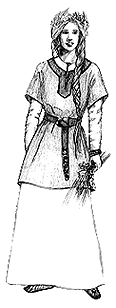 The early medieval period is characterized by relatively
simple shapes, with decoration chiefly being in the form of woven and block printed fabrics. Women
typically wore at least two layers; the outer garment would be shorter and have shorter sleeves, and
would be more heavily decorated at the hem, neck and cuffs, and potentially at the middle arm and in
a second row above the hem. The shape of each garment was essentially a T, with the arms sticking
straight out from the shoulders, and with little shape to the waist - a belt was always worn to
control the fullness of the garment.
The early medieval period is characterized by relatively
simple shapes, with decoration chiefly being in the form of woven and block printed fabrics. Women
typically wore at least two layers; the outer garment would be shorter and have shorter sleeves, and
would be more heavily decorated at the hem, neck and cuffs, and potentially at the middle arm and in
a second row above the hem. The shape of each garment was essentially a T, with the arms sticking
straight out from the shoulders, and with little shape to the waist - a belt was always worn to
control the fullness of the garment.
Later in the period, women began to shape their clothing with the addition of triangular pieces of fabric (gores), inserted in the sides of the tunics at the armhole or waist to make the line of the tunic flare outward. Clothing had very little in the way of fastenings, being mainly pulled over the head, but in about the 12th century, women began to lace the sides of their dresses tighter across the middle, to produce a more form-fitting silhouette.
Very long underdress sleeves were fashionable, often being made long enough to extend right over the hand. To enable the use of the hands, sleeves were made tight enough that the wrists would not slide over the hands, but instead force the fabric to wrinkle and bunch along the forearm, creating a fairly narrow silhouette that was not binding or constrictive. The overdress sleeves gradually grew longer, and then wider as they began to approach the wrist. Soon the characteristic shape of the outer sleeve became a normal width until the middle of the forearm, where it widened out into a bell or trumpet shape that could be as wide as three or four feet.
Coarsely woven hose were worn on the legs, usually held up by garters or ties. Shoes remained fairly functional, although pointed toes began to become fashionable in the 13th century.
The hair of unmarried women could be worn loose or uncovered; married women ordinarily wore a veil over their hair, and often a wimple wound about the head and neck under the veil.
Early Fourteenth Century
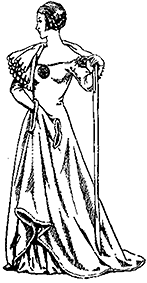 As seamstresses became more sophisticated, the cut and fit of garments improved dramatically. The
signature silhouette of the early 14th century was the cotehardie, a tunic-like garment that was
extremely closely fitted. Fashion began to dictate more strictly the shape of the body, for the dress
was so figure-following that every contour could be revealed - at least above the hips. Cotehardies
for women (for both men and women wore the style) were tightly fitted through to the top of the hips,
using a multitude of buttons at the front and at the wrist, but the skirt broadened expansively from
the hips, and trailed far behind the wearer.
As seamstresses became more sophisticated, the cut and fit of garments improved dramatically. The
signature silhouette of the early 14th century was the cotehardie, a tunic-like garment that was
extremely closely fitted. Fashion began to dictate more strictly the shape of the body, for the dress
was so figure-following that every contour could be revealed - at least above the hips. Cotehardies
for women (for both men and women wore the style) were tightly fitted through to the top of the hips,
using a multitude of buttons at the front and at the wrist, but the skirt broadened expansively from
the hips, and trailed far behind the wearer.
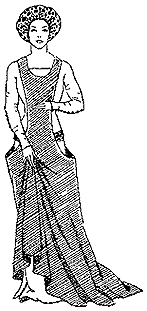 Belts were still worn by everyone, since there were no pockets in the clothes. Since the line of the
outer gown often precluded a belt being worn, the belt would be worn over the underdress, and
decorated slits cut in the overdress to allow access to pouches and purses worn on the belt or girdle.
Belts were still worn by everyone, since there were no pockets in the clothes. Since the line of the
outer gown often precluded a belt being worn, the belt would be worn over the underdress, and
decorated slits cut in the overdress to allow access to pouches and purses worn on the belt or girdle.
Again, an underdress was worn beneath the cotehardie, also rather closely fitted, but of a lighter material, allowing excess fabric to be crushed to the body in discreet amounts. Since the outer dress was so long (often between 6 to 8 inches longer than the wearer), it was frequently picked up to allow freedom of movement, thereby exposing the hem of the underdress. With that in mind, the hem of the underdress might also be decorated, to provide a pretty edge when revealed.
Another type of overgown, called a surcoat, could be worn over the cotehardie. Called a sideless surcoat because of its lack of sleeves, the gown began to narrow in the torso as the century progressed, eventually becoming almost a mere strip from waist to shoulder in front and back. Often these strips would be heavily edged with fur and studded with jewels or cabochons.
Hose became a bit more form-fitting, but was still held up by garters or ties. Shoes began to lengthen and point, although not too long, since they would collide with the voluminous skirts.
Unmarried women could still wear their hair loose, although a variety of braided styles became popular. Braids were coiled on the sides of the head, or around the back, or encased in little boxes over each ear and bound to a headband. Married women often wore the same styles, but underneath a veil or in combination with a wimple.
Later Fourteenth Century - Early Fifteenth Century
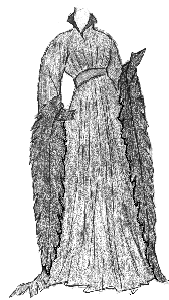 In an age where all your wealth could actually be shown to someone, ostentation of dress became an
increasingly important factor in determining fashion. Around the turn of the century, the culmination
of this principle was the houppelande. Yards and yards of beautiful outer fabric, yards and yards of
beautiful lining fabric (or even fur!), and as much trimming, embroidery and even bells as the
shoulders could support.
In an age where all your wealth could actually be shown to someone, ostentation of dress became an
increasingly important factor in determining fashion. Around the turn of the century, the culmination
of this principle was the houppelande. Yards and yards of beautiful outer fabric, yards and yards of
beautiful lining fabric (or even fur!), and as much trimming, embroidery and even bells as the
shoulders could support.
The houppelande is also the last medieval style worn by both sexes. The body of the garment angled sharply outward from beneath the arms, creating a tent-like mass of fabric that was pleated carefully across the chest and held in place by a belt. Women wore their belts quite high, often right under the bust, to accentuate the currently fashionable figure, which was small-breasted with a prominent belly.
The sleeves were loosely fitted to just above the elbow, and then opened out in an enormous bell shape, with the ends of the sleeves frequently dragging on the floor. "Dagging," the fashion of cutting the edges of fabric into intricate repeating shapes, decorated the edges of sleeves, which were usually lined with a contrasting fabric or perhaps with squirrel or ermine.
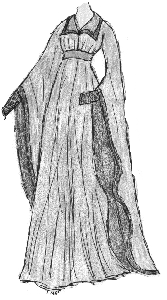 The underdress could also contrast, and its sleeves were usually closely fitted, although there are
some examples of short dagged wrists. Again, since the garment was so long, some women decorated the
hems of their underdresses, so that they might be seen when the houppelande was lifted for walking.
The underdress could also contrast, and its sleeves were usually closely fitted, although there are
some examples of short dagged wrists. Again, since the garment was so long, some women decorated the
hems of their underdresses, so that they might be seen when the houppelande was lifted for walking.
Hose and shoes remained largely the same as the earlier part of the century, with a continuing gradual extension of the point of the shoe.
Flower-garlanded hair was popular with young women, who also continued to braid their hair in intricate patterns. Fanciful hats also began to appear, with trimmings and bells, but not fully displacing the veil, especially for older women.
Later Fifteenth Century
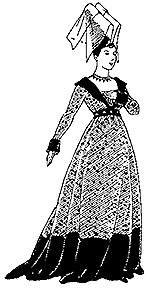 As the 15th century progressed, women's fashion became more and more fantastic. Prior to then, women's
clothing had been lavish at times, but was still relatively functional and comfortable. The gowns of
this later period remain fairly comfortable, but the total outfit became more taxing to wear,
especially the headdresses.
As the 15th century progressed, women's fashion became more and more fantastic. Prior to then, women's
clothing had been lavish at times, but was still relatively functional and comfortable. The gowns of
this later period remain fairly comfortable, but the total outfit became more taxing to wear,
especially the headdresses.
Gowns retained the high waist of the houppelande, and the expansive skirts (with now even longer trains), but sleeves shrank back to the wrist and bodices became more fitted. Around this time, set- in sleeves developed, allowing a very closely fitted sleeve and shoulder, and that narrow shape extended to the bodice of the gowns. A small bust remained very fashionable, for with the waist of the gown immediately below the bust, anything else would look out of proportion.
The neckline of the overgown began near the shoulders and plunged to the waistline of the gown. It was usually edged with a different fabric, or sometimes fur, that would make an attractive contrast with the square-necked undergown. The effect was of an upside-down triangle set into the neckline of the gown. For modesty, some women also wore a pale, high-necked, lightweight chemise under the undergown, raising the effective neckline of the gown but not clashing with the colour scheme.
Hose remained much the same, with gradual movement towards knitted stockings, which fit much more closely and were far more comfortable. Shoes continued to lengthen and point, but without much of a heel.
Women's headdresses reached colossal proportions during this period, with an enthusiasm for construction that would not be matched until the eighteenth century. The most familiar shapes was that of the hennin, the tall cone-shaped hat so dear to our Hallowe'en princess costumes. The hennin could be single or double-pointed, and usually had a veil or veils draped over and from the points of the headdress. An elaborate system of counterbalancing was necessary to get the hennin to stay on the head, rendering the wearer almost incapable of swift movement, and causing many a neckache by the end of the night by the necessity of sitting rigid and still to keep the cones and points in place.
The forehead became a major feature in determining a woman's beauty, and a high, clear forehead was much prized. For those not born with a high forehead and pale hair, it was necessary to pluck the hairline to push the forehead back.
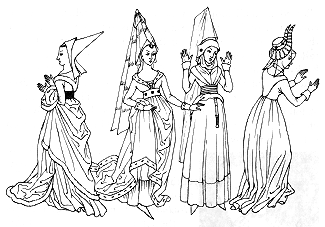
Early Sixteenth Century
Around the turn of the century, the waistline began to fall toward the natural waist, but the bodices of gowns retained their fitted shape. Instead of retaining the rounded projection of the bust so popular in the 15th century, however, a move toward a more cylindrical torso gained momentum, bringing about more extensive use of corsets and corset-like undergarments. As the century progressed, the female silhouette came to resemble two cones with their points joined in the middle.
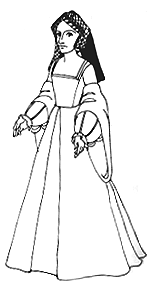
The corset, in addition to providing a smooth line for the bodice, did push up the bust (it had to go somewhere!). Necklines began to square out, often with the gathered edge of the chemise peeking out of the neckline. For more modest women, a dickie-like garment called a partlet could be added to cover the bosom, being simply a piece of fine, light fabric that had a high, fitted collar, extended down below the bosom - tucked into the neckline of the gown - and then tied under the arms.
To create the illusion of a narrow waist (the 16th century corset, as mentioned, did not so much compress the waist as simply smooth out the line of the torso), skirts became larger and the hips exaggerated. Underneath the skirts of the gown, a bumroll or a farthingale could be worn. The bumroll was a croissant-shaped piece of stuffed fabric that tied around the waist, created a shelf over which the skirt would fall; to increase the fullness, a skirt worn with a bumroll was usually heavily pleated and gathered at the waist. A farthingale was an early kind of hoopskirt, with a cone-shaped skirt stiffened and held out by rings of cane or whalebone.
The entire ensemble continued to be layered in several pieces. A chemise was always worn, and sometimes peeked through decorative cuts and slashes in the overgarments. Two sets of sleeves were usual, with the pair underneath either attached directly to the overgown or set onto a lighter weight underdress. The skirt of the overgown was often open in the front, to expose a contrasting and often heavily decorated underskirt.
The gowns of this period became stiffer and more voluminous, moving away from the more fluid fabrics of the previous century; brocades and heavy velvets held the dual-cone shapes more readily. In the North, especially in England, the undersleeves of the gown became enormously overgrown from the elbow down, often stuffed with horsehair and bombast to create large loaf-shaped sleeves which required the wearer to hold her elbows out at an angle at all times. The oversleeves were often lined in yet another contrasting fabric and pinned back above the huge undersleeves, the better to display the beautiful colours.
Knitted hose gained in popularity, but were still largely restricted to woolen yarns. Shoe points shrank, and small, squarish heels began to appear.
The awkward headdresses of the previous century fell out of favor, and were reduced to smaller, stiffened coifs, from which depended matching veils that covered the hair. The shape of the coif hugged the contours of the face, often coming to a point over the cheeks.
Late Sixteenth Century
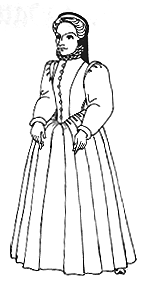
By the end of the century, women's clothing had developed into the "Elizabethan" style most commonly seen among Faire-style reenactors. The rigidly held torso remained, and around that framework gowns grew larger and even more ornate. As the name would suggest, this distinctive silhouette was most prevalent in England, where the Queen (a diminutive woman in a powerful position) made herself a physical presence to be reckoned with by the amount of room she needed.
While the Tudor styles had allowed for a bare neckline, it became more common to draw the neckline all the way up to the chin. The ruffle at the neck of the chemise grew and grew until it became a huge starched ruff, an entirely separate garment made out of yards and yards of stiffly folded linen. Perhaps because of its extreme awkwardness (special long-handled eating utensils were sometimes necessary even to eat, since the arms could not reach around the ruff), it also developed into a "split ruff," with the ruff beginning at the corners of the neckline and curving around the head in a sort of frame. The bisection of the ruff also had the effect of baring the upper chest, and unobstructed cleavage came back into fashion.
In addition to the cone-shaped farthingale ("Spanish"), a new "cartwheel" farthingale that stuck straight out from just above the hips was imported from France. Now instead of the illusion of the large, shapely bottom provided by the bumroll and the Spanish farthingale, a woman's lower body took on the look of a large round table, with yards of fabric depending from the very edge. The layering of the earlier part of the century continued, with the opening of the overgown often spread apart to show the fabric of the underskirt.
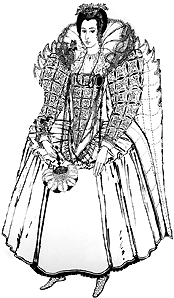
In an effort to balance the enormous skirts, the bulk of a gown's sleeves moved up to the shoulder, with large padded sleeve-heads and shoulder-rolls. Again emphasizing layering, one might see a stuffed and brocaded undersleeve completely exposed, which the oversleeve was split open and extended to the floor behind the shoulder. Large veils, sometimes echoing the shape of the bisected ruff, completed the heavy upper silhouette.
Nearly all people of consequence were wearing knitted hose by this point. Although wool was by far the most common fabric, Elizabeth's wardrobe records show that she owned several pairs of knitted silk stockings, which she preferred above all others. Relatively subdued shoes with small heels persisted, perhaps because there needed to be at least one area of the body that was simple.
Small caps and veils predominated as hairpieces, with the stiffened coifs of the early part of the century being replaced by elaborately curled, frizzled, and braided hair, studded with jeweled ornaments. For outdoor wear, many women also adopted taller hats similar to those worn by men, worn with no veiling. Red hair was wildly popular, largely because that was the colour of the Queen's own hair.
The images on this page are designed to give you a quick and clear reference to the distinctive silhouette of each period. There are many, many galleries on the web that can provide a much broader idea of both the variations in styles and also the colours and decorations that enlivened them. For some jumping-off points, consult the Costume Links page.
If you have any questions about this pages or the materials contained therein, please contact Carla Emmons, my most gracious maid of honour.